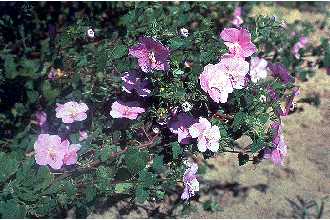Texas Swampmallow
Scientific Name: Pavonia lasiopetala Scheele

| General Information | |
|---|---|
| Usda Symbol | PALA13 |
| Group | Dicot |
| Life Cycle | Perennial |
| Growth Habits | ShrubSubshrub, |
| Native Locations | PALA13 |
Plant Guide
Use soil moisture sensors to measure the soil moisture of Texas Swampmallow.
Fact Sheet
Alternate Names
Texas Swampmallow, Rose Mallow, Rockrose, Rose Pavonia
Uses
Wildlife: Wright pavonia provides dense cover for birds and small mammals. The flowers attract many species of pollinators as well as hummingbirds. The foliage is browsed by deer and small animals. The seed provides food to many different species of game birds and small mammals. Landscaping & Beautification: Wright pavonia produces a beautiful pink to red flower that adds color to native gardens and landscaping. Livestock: Wright pavonia is highly palatable to sheep, goats, and cattle.
Status
Please consult the PLANTS Web site (http://plants.usda.gov) and your State Department of Natural Resources for this plant’s current status (e.g., threatened or endangered species, state noxious status, and wetland indicator values).
Weediness
This plant may become weedy or invasive in some regions or habitats and may displace desirable vegetation if not properly managed. Please consult with your local NRCS Field Office, Cooperative Extension Service office, state natural resource, or state agriculture department regarding its status and use. Weed information is also available from the PLANTS Web site at plants.usda.gov. Please consult the Related Web Sites on the Plant Profile for this species for further information.
Description
Wright pavonia is a native, upright, shrubby, perennial, warm-season forb that can grow 2-4 feet tall. The flowers are solitary on slender stems with five petals. They have a rose-red to pink color and will bloom from June through the fall time of the year. Its leaves are alternate with coarsely toothed or lobed margins. The leaves grow from one to two and a half inches long. Seed can be easily collected from mature flowers.
Adaptation
Wright pavonia is found in Texas from the Edwards plateau south to the Rio Grande Plains and Trans-Pecos area. It is adapted to a wide range of soil types, but performs best on sandy to medium textured soils that are well-drained. Wright pavonia distribution from USDA-NRCS PLANTS Database. For updated distribution, please consult the Plant Profile page for this species on the PLANTS Web site.
Establishment
Wright pavonia should be planted on a clean, firm seedbed. Planting can be done using either a grass drill or broadcast seedling. When broadcast seeding, additional soil disturbance may be necessary to maximize seed-soil contact. Seed is planted ¼ to ½ inch deep at a rate of 7.0 lbs pure live seed (pls) per acre to establish approximately
Management
Wright pavonia is used as a component in seed mixtures for ranges and pastures. Grazing should not be permitted the first year in order to allow plants to establish strong root systems. Although Wright pavonia reseeds itself readily, proper management is required to ensure the plant is not overgrazed or over utilized by livestock or wildlife. Consult your local NRCS Field Office for assistance with planning and applying prescribed grazing.
Pests and Potential Problems
None Known
Environmental Concerns
None Known
Control
Please contact your local agricultural extension specialist or county weed specialist to learn what works best in your area and how to use it safely, Always read label and safety instructions for each control method, Trade names and control measures appear in this document only to provide specific information, USDA NRCS does not guarantee or warranty the products and control methods named, and other products may be equally effective, Cultivars, Improved, and Selected Materials (and area of origin) Kerr Germplasm was originally collected by the Soil Conservation Service (SCS) San Antonio nursery in the early 1960’s, Use soil moisture sensors to measure the soil moisture of Texas Swampmallow., After the nursery closed, the germplasm was moved to Waco, TX and later to the Knox City PMC in 1966, Seed produced at the PMC was used to establish a native population at the Texas Parks and Wildlife-Kerr wildlife Management Area near Hunt, TX,
